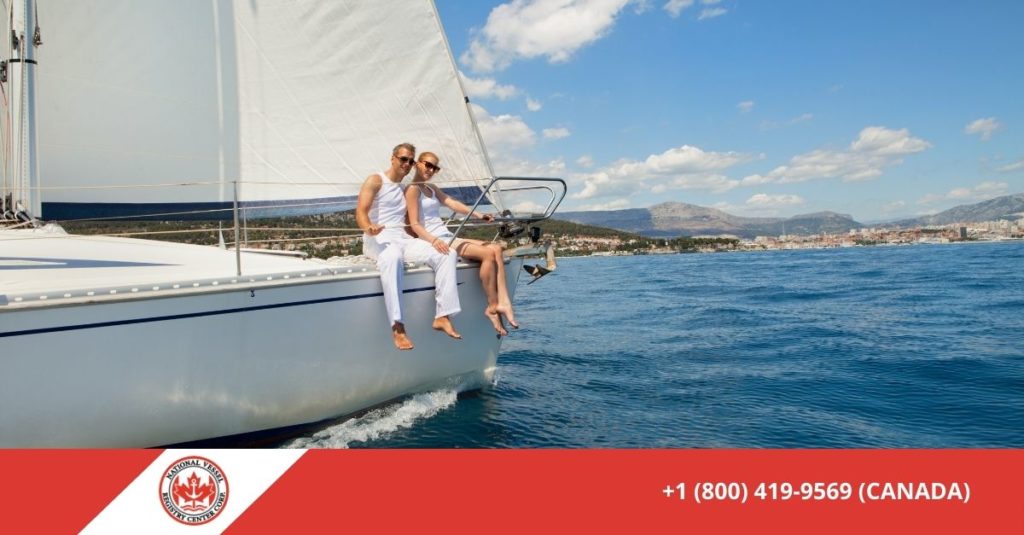Only a copy of a bill of sale will prove you own your Canadian vessel. Don’t get ownership confused with registration or licensing. You cannot use a registration or license to prove you own a pleasure craft.
Canadian Ownership and Licensing
While a copy of your bill of sale should be kept onboard at all times, you also need to show your Canadian vessel is properly licensed. You will use the license or its number, which is featured on the boat’s side, for purposes of identification for search and rescue (SAR), or to locate you for similar reasons.
You can compare the number to a license you display on a car. However, you’ll never need to renew it. Make sure the number is at least 3 inches high (7.5 centimeter) and that its color contrasts with the bow color of the boat.
You can show proof you can operate the boat with a pleasure craft operator card (PCOC). If you’re the one operating the boat, you need to have this endorsement. You can test for and get the card online through a Transport Canada affiliate training center.

Keep a Copy of the Bill of Sale on Your Boat at All Times
Again, your copy of the bill of sale for your boat should be maintained on the boat at all times. You’ll need a bill of sale to register for licensing. So, if you purchase a pleasure craft, you have 90 days to transfer your boat’s license into your name from the date of sale.
To apply for licensing, you need to have a government photo I.D. and, as noted, your bill of sale. If you’re buying a used boat, you’ll just need the license number from the boat’s side to complete your license application.
What Happens If You Buy a New Boat?
If your boat is a new boat, the boat dealer will take care of the license transfer. They’ll need a copy of your government-issued picture I.D. and a third-party authorization document that has been signed and confirms that the dealer can license the boat. He or she will also need the bill of sale.
Different provinces have varying processes for licensing a boat. If you operate your boat without a license, authorities can issue a $250 fine. Therefore, besides your boat’s bill of sale (to show you own the boat), you also need a paper facsimile of your pleasure craft license.
Why the Bill of Sale Is Important for Ownership
You can see how the bill of sale is used for ownership, as it must list several bits of key information. This information includes the following details:
- The hull I.D. number*
- The name and port of registry (for named boats that are larger)
- The buyer’s or buyers’ name(s), addresses, and signatures
- The name(s), address(es), and signature(s) of the seller(s)
The Hull I.D. Number (HIN)
*The HIN represents a one-of-a-kind 12-digit number given to a pleasure craft that is manufactured, built, rebuilt and meant to be sold or operated in Canada. You must place the HIN where it can easily be seen when the boat is operating.
Regulators direct boaters to place the HIN on the exterior of the boat on the right (starboard) side of the boat’s transom, or the vertical rear section of the boat. If the boat does not feature a transom, boaters should place the number on the starboard size on the hull’s rear.
Reporting Name and Address Changes During a Sale
Sellers of boats used for pleasure must report a name change and address through Transport Canada. As the seller, you should sign the reverse of your vessel license and give it to the buyer. In turn, the buyer must complete and sign the reverse side of the license so it can be submitted to Transport Canada.
The Transfer Deadline after a Sale
This transfer must take place within 90 days. As long as the documents are onboard and the ship shows the name and address change, the owner may operate the boat. Make sure your owner’s information is always kept up to date.
Registering Your Canadian Vessel
Canadian small vessel regulations require boats that have motors sized 10 horsepower or more to be licensed. However, as a boat owner, your registration for your pleasure craft is voluntary. If you register your boat by its name, you don’t need to include the license number. The name should be unique, as similar or phonetically close-sounding names can lead to problems in locating a boat during an emergency.
Legal and financial advisors support registration, as it gives the boat owner additional proof that they own their vessel. You can also take out a marine mortgage if you have this type of backup.
Transport Canada sends out an inquiry every 3 years about registration to confirm registration and ownership. To verify your status, you need to verify your address and that you’re still the boat’s owner.
Final Thoughts about Canadian Vessel Ownership
While licensing, a boat operation card (PCOC), and registration tie into ownership, they cannot be used to show proof that you’re a boat’s owner. Only your bill of sale can satisfy this requirement for a Canadian vessel.

